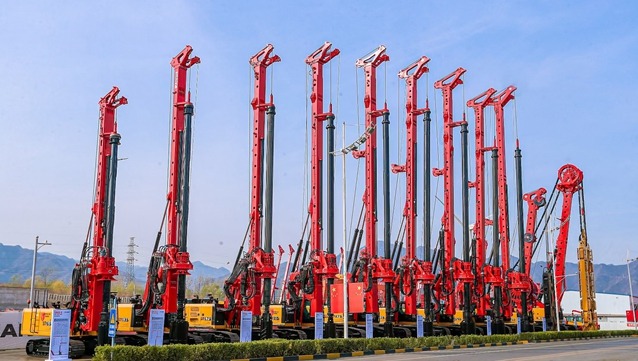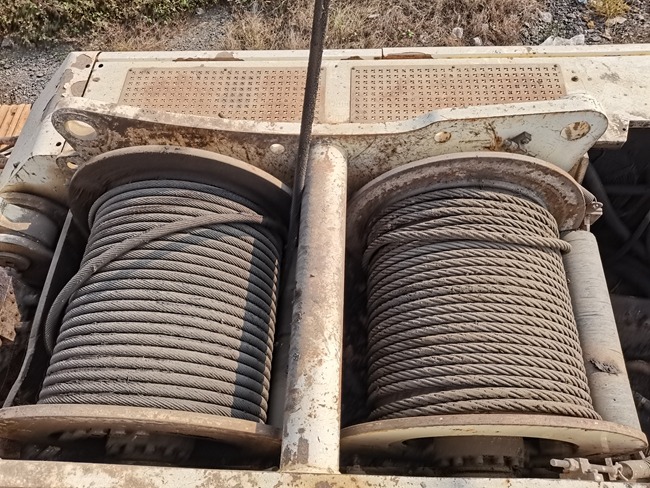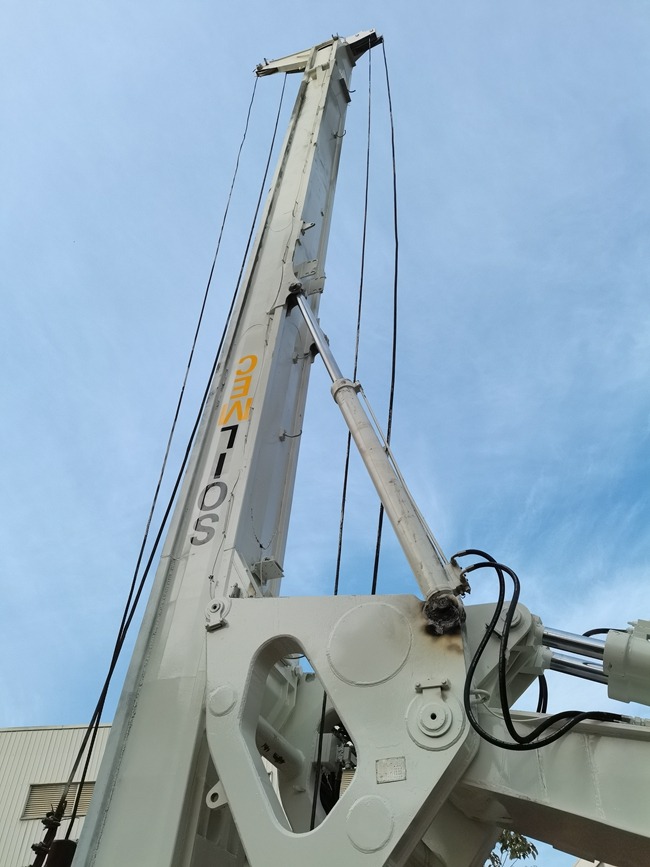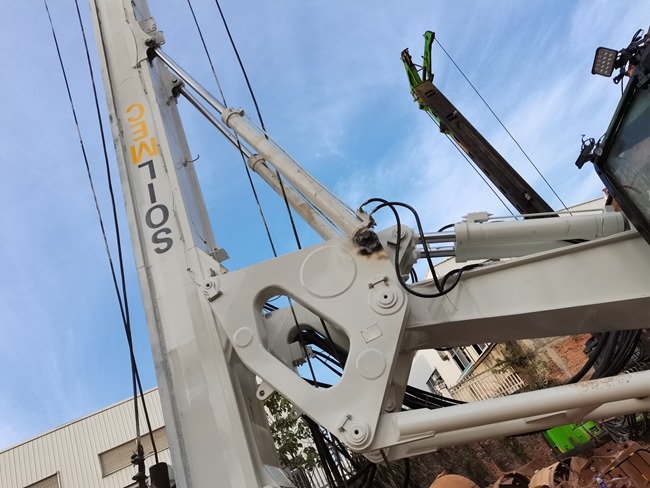Insufficient Torque of Power Head of Rotary Drilling Rig
Fault phenomenon: The power head torque of the rotary drilling rig is insufficient during drilling construction, the forward and reverse rotation speeds of the power head are insufficient, and there are abnormal noises when the power head motor and reducer are running.
Failure analysis: Insufficient torque of the power head can be considered from both hydraulic and mechanical aspects: 1. Insufficient hydraulic oil pressure in the hydraulic system; 2. Power head motor failure, reducer failure gear box failure, etc.
cause of the issue:
1. The pilot pressure is insufficient or the relief valve setting pressure is too low;
2. The power head motor is damaged or the hydraulic oil leaks heavily;
3. The parts of the power head reducer are damaged;
4. The power head gearbox mechanical device is damaged.
Troubleshooting method:
1. Check that the main system pressure of the hydraulic system is normal, indicating that there is no problem with the hydraulic system and consider mechanical damage;
2. During the inspection of the hydraulic system, it was found that there were small-scale periodic abnormal noises in the reducer and motor when the power head was running. Disassemble the power head motor and check the motor and output shaft. They are normal;
3. Remove the reducer and disassemble the reducer. Note: When disassembling, keep the disassembly environment clean and pay attention to the disassembly sequence to facilitate installation. A careful inspection inside the reducer revealed damage to the gear. When disassembling the reducer, pay attention to the order of the parts. All bolts, gaskets, and parts must be cleaned. At the same time, the inside of the reducer must be kept clean during installation;
4. Replace the damaged gear, reinstall the reducer and motor, restore the drilling rig power head, and the drilling rig returns to normal operation.
Troubleshooting experience: Mechanical damage to the power head reducer will cause insufficient output torque of the power head, and abnormal noises can be heard. Be sure to find the problem in time to avoid expanding the scope of damage.
The Rotary Drilling Rig Rope Press Cannot Rotate
Fault phenomenon: The rope press of the rotary drilling rig is stuck and cannot rotate, and the wire rope is seriously worn.
Failure analysis: The rope press cannot rotate, and the wire rope is severely worn. Generally, the rope press is not maintained in time, and there is a lack of lubricating oil in the rope press, which causes the rope press to rotate inflexibly and deform, and even the internal bearings of the rope press are damaged and stuck. lag, the rope press wears the wire rope.
cause of the issue:
1. There is a lack of lubricating grease inside the rope press;
2. The rope press is deformed;
3. The internal bearing of the rope press is damaged and stuck.
Troubleshooting method:
1. On-site inspection of the rope press shows that it is not deformed and the surface of the rope press is severely worn;
2. Disassemble the rope pressure device and check that there is a lack of lubricating grease in the rope pressure device;
3. After further disassembling the rope press, it was found that the internal bearing of the rope press was damaged, causing the rope press to be unable to rotate;
4. Replace the internal bearing of the rope press, reinstall the rope press, add lubricating grease, and troubleshoot.
The Mast Cylinder of the Rotary Drilling Rig Is Leaking Oil and the Mast Is Not Vertical.
Fault phenomenon: The mast cylinder of the rotary drilling rig leaks oil and the mast is not vertical.
Failure analysis: The mast cylinder piston rod head is broken or the mast cylinder oil seal is damaged, causing the mast cylinder to leak; if the mast is not vertical, you can start with the oil cylinder and the mast cylinder balance valve. Internal leakage of the oil cylinder or internal leakage of the balance valve can also cause the mast to not be vertical. vertical.
cause of the issue:
1. The mast piston joint head is broken;
2. The oil seal of the mast hydraulic cylinder is damaged;
3. Internal leakage of balance valve.
Troubleshooting method:
1. The inspection found that there were cracks in the piston joint head of the oil cylinder. Further investigation: the mast oil cylinder was disassembled and inspected, and it was found that there were some obvious spots and shallow grooves on the surface of the oil cylinder;
2. Open the entire cylinder and oil seal and find that the cylinder oil seal and O-ring are damaged, and the gasket is cracked, causing oil leakage in the cylinder;
3. Replace the oil seal, sealing ring, and gasket, and reinstall the oil cylinder. The test showed no leakage and the drilling rig returned to normal.
Troubleshooting experience: When the main hoisting wire rope of the rotary drilling rig is operated improperly, it will touch the outer surface of the piston rod of the mast cylinder, which will cause damage to the surface of the piston rod of the cylinder and create grooves, which will lead to damage to the cylinder seal and oil leakage from the cylinder. Phenomenon. Leakage in the mast cylinder will cause malfunctions such as the upright mast not being straight, and the upright mast and inverted mast cylinders being out of sync. When a fault occurs, it should be eliminated and repaired promptly to prevent the fault from expanding.
The Main Winch Dropped Abnormally After the Rotary Drilling Rig Was Started.
Fault phenomenon: The main winch abnormally drops the drill after the rotary drilling rig is started.
Failure analysis: After the rotary drilling rig was started, the main winch abnormally dropped the drill. Measure the brake pressure when the drilling rig is running but does not move. If the pressure value is normal, the friction plate of the main winch reducer is damaged, the floating solenoid valve is stuck, the main winch balance valve is damaged, etc., which can cause the main winch to be abnormal. Drop the diamond.
cause of the issue:
1. The friction plate is damaged;
2. The floating solenoid valve is stuck;
3. The main winch balance valve is damaged;
4. The brake cylinder spring is deformed.
Troubleshooting method:
1. Block the brake oil circuit and lift the main winch. At this time, the main winch has no action. It can be judged that the friction plate is normal;
2. Open the interface between the floating oil pipe and the balance valve (the shuttle valve connection) without operating it, and find that the drill still falls off. Troubleshoot the floating solenoid valve;
3. Connect the pressure gauge and the brake oil line with a three-way joint. When lifting and lowering, the pressure reaches the normal range, but the pressure cannot return normally, indicating that the balance valve is stuck. Adjust the brake relief valve to modulate the pressure until the drill pipe does not fall. At this time, when the drill pipe is lifted and released, the brake friction plate cannot open normally because the pressure is too low. Adjust the pressure to the standard value, the friction plate can be opened, and the drill dropout phenomenon occurs. The balance valve was disassembled and cleaned, but still to no avail. The balance valve is still stuck and cannot work properly and needs to be replaced;
4. Replace the balance valve with a new one and the drilling rig returns to normal. Pay attention when replacing: ensure the cleanliness of the hydraulic system and prevent contamination. After installation, the pressure test is normal before the drilling rig is delivered to the customer.
Troubleshooting experience: The drilling rig should be well maintained and maintained to ensure the cleanliness of the hydraulic oil to prevent contaminants from entering the hydraulic system damaging hydraulic components and causing malfunctions. Regularly check the brake pressure of the winch to ensure that the brake pads are opened normally.
Mast Cylinder Works out of Sync
Fault phenomenon: After the rotary drilling rig has been working for some time, the mast deflects and the two mast cylinders work out of sync.
Failure analysis: After the rotary drilling rig has been working for a while, the mast deflects and the two mast cylinders work out of sync. This may be a problem with the cylinder balance valve or internal leakage of the mast cylinder.
cause of the issue:
1. Balance valve problem;
2. Internal leakage of the oil cylinder.
Troubleshooting method:
1. Turn on the machine and tilt the mast to about 45 degrees, then stop and turn off the engine. Remove the two oil pipes on the balance valve and connect two clean plastic bags to ports A and B of the balance valve. If no oil leaks out after some time, but the length of the cylinder piston rod becomes shorter, it means there is no problem with the balance valve and the cylinder is leaking. On the contrary, it is a balance valve problem;
2. After testing, the mast cylinder was retracted and the piston rod became shorter. After the pipeline is opened for some time, the balance valve leaks. Adjusting the bolt of the balance valve has no effect, and the oil cylinder moves slowly. It can be determined that the balance valve is leaking or the valve core is stuck;
3. Remove the balance valve and inspect it. After disassembly, it was found that there was a circle of scratches on the cone surface of the small cavity valve core of the balance valve, and the hydraulic oil leaked from there, causing the mast cylinder to work out of sync with the other cylinder during operation, and the mast tilted to one side;
4. Replace the balance valve, restore the mast cylinder to normal operation, and eliminate the fault.
Troubleshooting experience: Troubleshooting requires careful observation and detection, and patiently troubleshooting possible fault points step by step from simple to complex.
Thank You!





